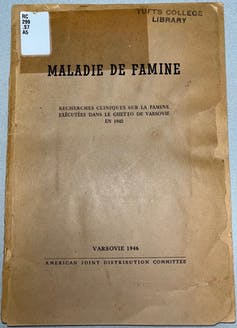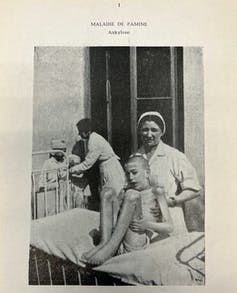Exactly 80 years ago, a group of starving Jewish scientists and doctors in the Warsaw Ghetto were collecting data on their starving patients. They hoped their research would benefit future generations through better ways to treat malnutrition, and they wanted the world to know of Nazi atrocities to prevent something similar from ever happening again. They recorded the grim effects of an almost complete lack of food on the human body in a rare book titled “Maladie de Famine” (in English, “The Disease of Starvation: Clinical Research on Starvation in the Warsaw Ghetto in 1942”) that we recently rediscovered in the Tufts University library.

This French translation was donated to the Tufts University library in 1948.
‘Maladie de Famine,’ American Joint Distribution Committee
As scientists who study starvation, its biological effects and its use as a weapon of mass destruction, we believe the story of how and why Jewish scientists conducted this research in such extreme conditions is as important and compelling as its results.
The clandestine project’s lead doctor, Israel Milejkowski, wrote the books’s foreword. In it, he explains:
“The work was originated and pursued under unbelievable conditions. I hold my pen in my hand and death stares into my room. It looks through the black windows of sad empty houses on deserted streets littered with vandalized and burglarized possessions. … In this prevailing silence lies the power and the depth of our pain and the moans that one day will shake the world’s conscience.”
Reading these words, we were both transfixed, transported by his voice to a time and place where starvation was being used as a weapon of oppression and annihilation as the Nazis were systematically exterminating all Jews in their occupied territories. As scholars of starvation, we were also well aware that this book catalogs many of the justifications for the 1949 Geneva Conventions, which made starvation of civilians a war crime.
A defiant medical record
Within months of their 1939 invasion of Poland, Nazi forces created the infamous Warsaw Ghetto. At its peak, more than 450,000 Jews were required to live in this small, walled-off area of about 1.5 square miles (3.9 square kilometers) within the city, unable to leave even to look for food.
Although Germans in Warsaw were allotted a daily ration of about 2,600 calories, physicians in the ghetto estimated that Jews were able to consume only about 800 calories a day on average through a combination of rations and smuggling. That’s about half the calories volunteers consumed in a study on starvation conducted near the end of World War II by researchers at the University of Minnesota, and less than a third of the average energy needs of an adult male.
